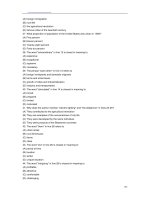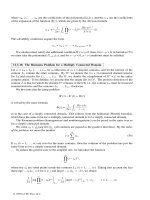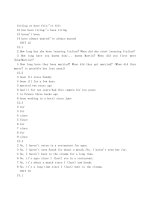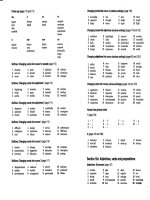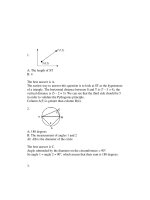Quantitative comparisons practice phần 9 potx
Bạn đang xem bản rút gọn của tài liệu. Xem và tải ngay bản đầy đủ của tài liệu tại đây (1.76 MB, 16 trang )
1.
A: The length of ST
B: 4
The best answer is A.
The easiest way to answer this question is to look at ST as the hypotenuse
of a triangle. The horizontal distance between S and T is (7 – 3 = 4), the
vertical distance is (5 – 2 = 3). We can see that the third side should be 5
in order to validate the Pythagoras principle.
Column A(5) is greater than column B(4).
2.
A: 180 degrees
B: The measurement of angles 1 and 2
AI: AB is the diameter of the circle
The best answer is C.
Angle subtended by the diameter on the circumference = 90
o
.
So angle 1 = angle 2 = 90
o
, which means that their sum is 180 degrees.
3.
)2,3(S
)5,7(T
A: The measurement of angles 2 and 6
B: The measurement of angles 1 and 5
AI: The illustration is not drawn to scale
The best answer is D.
All we know about this problem is that angles 1, 2, 5 and 6 sum up to 180
degrees and that is not sufficient. Hence the relationship is indeterminate
and the right answer is D.
4.
A: The measurement of angles 3 and 4
B: The measurement of angles 5 and 6
The best answer is A.
Angles 3 and 4 are supplementary angles on a straight line and therefore
their sum is 180. Angles 5, 6, 1 and 2 sum up to 180 and therefore 5 and 6
by themselves are smaller than 180 degrees.
5.
A: 2BC
B: AB + AC
AI: Angles 1 and 2 are equal
The best answer is D.
The question only implies that the triangle is an isosceles and that is not
enough. BC can be as small or big as we want and still the triangle can be
an isosceles and therefore the right answer is D.
6.
A: The measurement of angles 1 and 2
B: The measurement of angle 4
AI: The illustration is not drawn into scale
The best answer is D.
Angles 3 and 4 are vertically opposite angles and so they’re equal to one
another. We have no further information about the triangle and relations
between the angles there. Angles 1 and 2 can be either larger or smaller
than 3 and therefore the answer cannot be determined.
7.
A: The length of BC
B: The length of AC
AI: Angles 1 and 2 are equal.
The measurement of angle BAC is 61 degrees.
The best answer is A.
Since the triangle is an isosceles and the top angle is 61 degrees, the two
base angles are equal to 59.5 degrees.
BC is in front of 61 degrees and AC is in front of 59.5 degrees and
therefore column A is greater.
8.
A: The measurement of angle 1 minus angle 3
B: The measurement of angle 6 minus angle 4
The best answer is C.
Angle 3 being an outer angle to the triangle is equal to angles 4 + 5.
Angle 1 being an outer angle to the triangle is equal to angles 5 + 6.
Angle 1 minus 3 is equal to angle 6 minus angle 4.
We can see that the columns are equal to one another.
9.
A: Twice the length of AB
B: The length of BD
AI: The measurement of the angle BAD is 30
o
.
The best answer is A.
Angle subtended by the diameter on the circumference = 90
o
.
So, ABD is a right triangle.
In a right triangle with an angle of 30
0
, the side in front of the 30 degree
angle is equal to half the hypotenuse, thus AB.
In other words AB = 2BD.
Column A = 2AB = 4BD.
Column B = BD and therefore the answer is A.
10.
A: Volume of a cube in which a length of a side is 7
B: Volume of a cube in which a length of a diagonal of a side is
72
The best answer is A.
Column A: The volume given the length of a side is 7
3
.
Column B: If side = X, then diagonal of a face = (X
2
+ X
2
)
1/2
= (2)
1/2
X.
72
=
236
= 6(2)
1/2
X = 6 and so the volume is 6
3
, which is smaller
than the volume in column A.
11.
A: The angle ABC
B: 55 degrees
AI: Consider an isosceles triangle, AB = BC.
AC
2
> AB
2
+ BC
2
The best answer is A.
Draw a sketch of the triangle.
If the triangle was a right triangle (ABC = 90
0
), AC
2
= AB
2
+ BC
2
.
Since the AC
2
> AB
2
+ BC
2
, the angle at the top (ABC) is larger than 90
degrees and column A is greater than column B.
12.
A: The measurement of the angle ABC
B: The measurement of the angle EDC
AI: AC is the diameter of the circle
The best answer is A.
Angle subtended by the diameter on the circumference = angle ABC =
90
o
.
The angle EDC lies on a line that is shorter than the diameter and
therefore it is smaller than 90
o
.
Column A is greater than column B.
13.
A
B
C
D
E
A
B
C
1
2
3
4
A: 225
o
B: The measurement of the angle 4
AI: The illustration is not drawn to scale
The best answer is A.
Angle 4 and angle 1 are on the same line and therefore their sum is 180
o
.
And therefore angle 4 must be smaller than 180 degrees, which means
that column A is definitely greater than column B.
14.
A: 2Y
B: X
The best answer is C.
Angle subtended by an arc at the center of a circle is double the angle
subtended by the same arc on the circumference, therefore X = 2Y.
Column A is equal to column B.
15.
A: AB x Z
B: AC x Z
AI: Angle 1 = angle 2
Z is a number between 0 and 50.
The best answer is C.
Since the triangle is an isosceles, AB = BC.
When you multiply each of the equal sides by the same number they
remain equal to one another and so the two columns are equal.
16.
X
Y
A: The largest angle in the triangle
B: 90
o
AI: consider a right triangle ABC
The best answer is C.
Since the triangle is a right triangle, there must be an angle of 90
o
among
the angles. The other angles sum up to 90
o
and so the largest angle must
be the right angle.
The columns are equal.
17.
A: 140
o
B: The sum of angles X and Y
AI: Y =
3
2
46 degrees
The best answer is C.
Angle subtended by an arc at the center of a circle is double the angle
subtended by the same arc on the circumference, therefore X = 2Y.
If Y =
3
2
46 , X must be
3
1
93 .
Column B = X + Y = 140
o
and so the columns are equal.
18.
A: The area of the square ABCD
B: The area of the circle
AI: The side of a square is
R
, where R is the radius of a circle
The best answer is D.
The area of the square is R
x R
= R
.
The area of the circle is
2
R
.
It seems like the area of the circle is greater yet the question didn’t
mention that R is not a fraction. If R is a fraction, for example ½, the area
of the square would be bigger. The right answer is D.
19.
A: The measurement of X
B: The measurement of Y
X
Y
X
Y
AI: The illustration is not drawn to scale
The best answer is D.
The only thing we know for sure is that X and Y are supplementary
angles and therefore X + Y = 180. No further information is available and
so we cannot determine the relations between X and Y and the right
answer is D.
20.
A: The ratio between the diameter of circle 1 to the diameter of circle 2
B:
2
AI: The area of circle 1 is twice the area of circle 2
The best answer is C.
The area of a circle dependent on the diameter is
4
2
d
.
The area of the first circle is
4
2
1
d
.
The area of the second circle is
4
2
2
d
.
We know that
4
2
1
d
= 2 x
4
2
2
d
22
2
1
2
2
2
1
d
d
dd .
Column A is equal to column B.
21.
A: The sum of the angles that are equal
B: 130
o
AI: Consider an isosceles triangle, one of the angles is 55
o
.
The best answer is B.
There are two possible angle arrangements in this circle: 55, 55, 70 or
55, 62.5, 62.5. In both cases, the sum of the equal angle does not sum up
to 130
o
or greater and therefore column B is always greater than column
A.
22.
A: The length of BD
B: The length of BC/2
A
B
C
D
3
5
AI: ABC is a right triangle at B.
The area of ABD is 2.25.
The best answer is B.
Since ABC is a right triangle, BC
2
+ 3
2
= 5
5
BC = 4 and therefore
column B = 2. The area of ABD is 2.25, write the following equation for
the area:
(BD x 3)/2 = 2.25 BD = 1.5.
Column A = 1.5 while B = 2 and therefore the answer is B.
23.
A: The area of ABCDE
B: 100
AI: The diagonal of the square is
210
BCD is an equilateral
The best answer is A.
The ratio between the sides of the square to its diagonal is 1:1: 2 and
therefore each side of the square and the triangle is equal to 10.
The height of the triangle is ( 75510
22
) and therefore the area of the
triangle is equal to
2
755
.
The area of the square is 100.
The area of both is 100 +
2
755
, which is surely greater than 100 and so
the answer is A.
24.
A: The circumference of one of the circles
B: The perimeter of the triangle ABC
A
B
C
D
E
A
B
C
AI: The equilateral triangle ABC is formed by connecting the centers of
three identical circles. The circles are tangential to one another.
The best answer is B.
We know that the circumference of a circle is equal to R
2 , which is
approximately 6.28R.
We can see that each side of the triangle is made up of two radiuses and
therefore the perimeter of the triangle is (2R)(3) = 6R.
6.28 > 6 and therefore column B is greater than column A.
25.
A: The area of the triangle ABC
B: The area of one of the circles
AI: The equilateral triangle ABC is formed by connecting the centers of
three identical circles. The circles are tangential to one another.
The best answer is B.
The area of a circle is simply
2
R
.
All we know about the equilateral triangle is that each of his sides is
equal to 2R, but this is sufficient.
The height of the ABC is
RRRR 334
222
.
The area of the triangle is base x height divided by two.
The area is 3
2
32
2
R
RR
.
3
and therefore the area of the circle is larger and so column B is
greater than column A.
26.
A: The volume of a cylindrical water tank that has a radius of 3 meters
and a height of 5 meters
B: The volume of a cylindrical water tank that has a radius of 2 meters
and a height of 10 meters
The best answer is A.
The volume of a cylinder in general is calculated according to: HR
2
.
Column A = .4553
2
Column B =
40102
2
.
A
B
C
Column A is greater than column B.
27.
A: BE
B: ED
AI: The measurement of angle ABD is 43 degrees.
The best answer is B.
ABC = ABD + DBC 90
o
= 43
o
+ DBC DBC = 47
o
.
ABD and BDE are alternate interior angles and thus equal.
BE is in front of a 43
o
angle.
ED is in front of a 47
o
angle.
Therefore, ED is greater since it is located in front of a larger angle.
28.
A: The area of the circle
B: 507
AI: The circumference of a circle is
26
The best answer is A.
The circumference of the circle is
26
, compare it with
R
2
.
R = 13.
The area of the circle can be easily calculated according to
2
R
.
The area =
16914.316913
2
.
169 x 3 = 507 and therefore
16914.3
is definitely greater than 507, which
makes column A greater than column B.
29.
A: Perimeter of a regular octagon with a side of 4.5
B: Perimeter of an equilateral triangle with a side of 12
The best answer is C.
An octagon has 8 sides and therefore it has a perimeter of 8 x 4.5 = 36.
An equilateral triangle has three sides and therefore it has a perimeter of
12 x 3 = 36. The columns are equal.
30.
A
B
C
D
E
A: Semi-circumference of a circle with a diameter of 28 inches
B: The perimeter of a regular nonagon with a side of 5 inches
The best answer is B.
Column A: The circumference of a circle with a diameter of 28 inches is
28
, which is approximately 88 inches (3.14 x 28).
The semi-circumference is 88/2, thus 44 inches (rounded up).
Column B: The perimeter of a regular nonagon (a nonagon has nine
sides) is equal to 5 x 9 = 45 inches and therefore column B is greater than
column A.
31.
A: The perimeter of a regular octagon with a side of 10
B: The perimeter of a regular decagon with a side of 8
The best answer is C.
An octagon has 8 sides and therefore its perimeter is 8 x 10 = 80.
A decagon has 10 sides and therefore its perimeter is 10 x 8 = 80.
32.
A: The volume of a rectangular solid with length of 4 inches, a width of 6
inches and a height of H inches.
B: The volume of a rectangular solid with length of 6 inches, a width of
3 inches and a height of Q inches.
The best answer is D.
This question takes seconds if you think instead of finding the volumes
right away. As you can see each of the columns is dependent on a
different variable (H and Q) yet no correlation between the two is given
and so the answer would be undeterminable.
The right answer in this case is D.
33.
A: X
2
+ Q
2
B: Y
2
+ Z
2
The best answer is C.
X
Y
Z
Q
Since the two triangles are right triangles with a common base, we can
use the Pythagoras principle to write the following equations:
Let’s name the common base B.
B
2
= X
2
+ Q
2
and B
2
= Y
2
+ Z
2
.
We can see that the columns are equal to one another.
34.
A: X + Y + Z
B: 230
o
The best answer is A.
All the exterior angles to the quadrilateral equal to 360.
We have one exterior angle missing, which can easily be found since her
supplementary angle is 55 and so the fourth exterior angle is equal to
(180 – 55 = 125
o
).
X + Y + Z + 125 = 360
o
X + Y + Z = 360 – 125 = 235
o
.
We can see that column A is greater than column B.
35.
A: X
3
B: Y
4
AI: 3
X
= 81
4
Y
= 64
The best answer is B.
3
X
= 81 X = 4.
4
Y
= 64 Y = 3.
Column A = 4
3
= 64.
Column B = 3
4
= 81.
Column B is greater than column A.
36.
A: A: The surface area of a cube whose volume is 343
B: 343
The best answer is B.
The volume of the cube is 343 and so each of its side is X.
X
3
= 343 X = 7.
o
X
o
Y
o
Z
o
55
The area of each face is X
2
= 49 and since there are 6 faces their area
together is 6 x 49 = 294, which is smaller than 343 and so column B is
the greatest.
37.
A: The measurements of the largest angle in triangle A
B: The measurements of the largest angle in triangle B
AI: The measures of the angles in triangle A are in the ratio of 2:4:6
The measures of the angles in triangle B are in the ratio of 1:2:6
The best answer is B.
Triangle A: Divide 180 by (2 + 4 + 6) to get the basic angular unit in the
triangle: 180/12 = 15
o
. The largest angle in this triangle is 6 units, or
6 x 15
o
= 90
o
.
Triangle B: Do the same here. The unit is 180/9 = 20
o
and so the largest
angle in this triangle is 6 x 20
o
= 120
o
.
Column B is greater than column A.
38.
A: The median angle in the triangle
B: 60
o
AI: The ratio between the angles in a triangle is 1:5:9
The best answer is C.
Divide 180 by (1 + 5 + 9) to get the basic angular unit in the triangle:
180/15 = 12
o
. The median angle in this triangle is 5 units, or
5 x 12
o
= 60
o
.
We can see that column A = column B.
1.
A: The number of bullets hitting the penny
B: 40
AI: The chances of a striking a penny with a gun bullet from 300 yards is 0.04%. A
gun man fires 10,000 bullets.
The best answer is B.
0.04% of 10000 = (0.04/100) x 10000 = 4.
Therefore Quantity B is greater.
2.
A: The number of anticipated winners in the raffle
B: 80
AI: The chances of winning the raffle are 0.08%. 10,000 people are participation in
the raffle.
The best answer is B.
0.08% of 10000 = (0.08/100) x 10000 = 8 and therefore column B is greater than
column A.
3.
A: The time it would take Sean to bike 100 miles
B: The time it would take Connell to bike 60 miles
AI: Sean bikes at 30 mph and Connell bikes at 15 mph.
The best answer is B.
Time = Distance / Speed
Time it takes Sean = 100/30 = 3 hour and a 1/3.
Time taken by Connell = 60/15 = 4 hours.
So Column B is greater.
4.
A: The energetic value of one liter of Kerosene
B: The energetic value of one liter of HTPB
AI: The energetic value of 4 liters of kerosene with 3 liters of HTPB is equal to the
energetic value of 2 liters of Kerosene with 7 liters of HTPB.
The best answer is A.
Let K represent Kerosene and H represent HTPB.
We can write the following equation: 4K + 3H = 2K + 7H
Simplify it 2K = 4H K = 2H and therefore the value of one liter of Kerosene is
twice the value of HTPB and so column A is greater.
5.
A: The value of an American dollar
B: The value of an Australian dollar
AI: The money value of 3 American dollars and 5 Australian dollars is equal to the
value of 2 American dollars and 8 Australian dollars
The best answer is A.
Let X be the number of American dollars and Y the number of Australian dollars. We
can write the following equation: 3X + 5Y = 2X + 8Y.
Simplify X = 3Y and therefore the value of an American dollar is greater than the
value of an Australian dollar.
6.
A: The value of the largest among the three
B: 104
AI: The sum of three consecutive numbers is 312
The best answer is A.
Let x-1, x and x+1 be the three consecutive numbers.
We know that x-1 + x + x+1 = 312 3x = 312 x = 104.
The largest among the three is equal to 105 and therefore column A is greater.
7.
A: The average (arithmetic mean) of the first and the last among those numbers
B: 54
The best answer is B.
AI: The sum of 4 consecutive numbers is 214.
Let x, x+1, x+2 and x+3 be the four numbers.
We can write the equation: x + x + 1 + x + 2 + x + 3 = 220.
4x + 6 = 220 x = 52.
The average arithmetic mean of the first and the second is
(52 + 55)/2 = 53.5, which is smaller than 54 and so column B is greater.
8.
A: The time it takes to run 3 Km at a rate of 150 meters per 10 seconds
B: The time it takes to run 2 Km at a rate of 80 meters per 12 seconds
The best answer is B.
Time = Distance / rate
Time
A
= 3000 / 150 = 20 x 10 = 200 seconds.
Time
B
= 2000 / 80 = 25 x 12 = 300 seconds and therefore column B is greater than
column A.
9.
A: 25 minutes
B: Y
AI: X cakes are baked by Z woman in 25 minutes.
X cakes are baked by Z + 3 woman in Y minutes.
The best answer is A.
The same number of cakes is baked by more women in less time and therefore Y
minutes are less than 25 minutes.
Column B is the greatest.
10.

